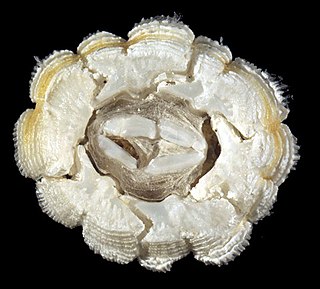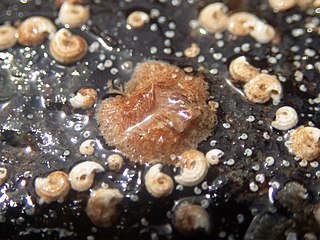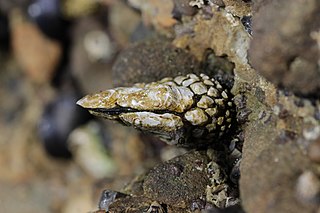
Barnacles are a type of arthropod constituting the subclass Cirripedia in the subphylum Crustacea, and are hence related to crabs and lobsters. Barnacles are exclusively marine, and tend to live in shallow and tidal waters, typically in erosive settings. Around 1,000 barnacle species are currently known.

Rhizocephala are derived barnacles that parasitise mostly decapod crustaceans, but can also infest Peracarida, mantis shrimps and thoracican barnacles, and are found from the deep ocean to freshwater. Together with their sister groups Thoracica and Acrothoracica, they make up the subclass Cirripedia. Their body plan is uniquely reduced in an extreme adaptation to their parasitic lifestyle, and makes their relationship to other barnacles unrecognisable in the adult form. The name Rhizocephala derives from the Ancient Greek roots ῥίζα and κεφαλή, describing the adult female, which mostly consists of a network of thread-like extensions penetrating the body of the host.

Thecostraca is a class of marine invertebrates containing over 2,200 described species. Many species have planktonic larvae which become sessile or parasitic as adults.

The Chthamalidae are a family of chthamaloid barnacles, living entirely in intertidal/subtidal habitats, characterized by a primary shell wall of eight, six, or four plates, lacking imbricating plate whorls, and either membraneous or more rarely calcareous basis. They are not found below immediate subtidal habitats, and more likely are found in the highest tier of shallow-water barnacle fauna. They can be found in the most rigorous wave-washed locations, and some species are found in the surf zone above high tide mark, only receiving water from wave action at high tide.

Acorn barnacle and acorn shell are vernacular names for certain types of stalkless barnacles, generally excluding stalked or gooseneck barnacles. As adults they are typically cone-shaped, symmetrical, and attached to rocks or other fixed objects in the ocean. Members of the barnacle order Balanomorpha are often called acorn barnacles.

Sessilia is an unranked clade of barnacles, comprising the barnacles without stalks, or acorn barnacles. They form a monophyletic group and are probably derived from stalked or goose barnacles. Sessilia is divided into two orders. The Verrucomorpha contain two families, Verrucidae and Neoverrucidae, and the remaining 14 families are in the order Balanomorpha.

The Balanomorpha are an order of barnacles, containing familiar acorn barnacles of the seashore. The order contains these families:

Ascothoracida is a small group of parasitic marine crustaceans, comprising around 100 species and divided into Dendrogastrida and Laurida. They are found throughout the world on cnidarians and echinoderms. Dendrogastrida are parasites on echinoderms, and Laurida are parasites on cnidarians, except from the species Waginella Grygier, which is also a parasite on echinoderms (crinoids). Piercing and sucking mouthparts are used for feeding, and more advanced forms also absorbs nutrients through a modified integument of the carapace. More basal forms are ectoparasitic, but most genera are meso- and endoparasitic. The sexes are separate, except from secondary hermaphroditic species of the Petrarcidae. In many species the larger female often have smaller males living inside her mantle cavity.

The Acrothoracica are an infraclass of barnacles.

Chelonibia is a genus of acorn barnacles in the family Chelonibiidae of the subphylum Crustacea. Its members are epizootic and live attached to manatees, turtles, marine molluscs, crabs and horseshoe crabs in all tropical and subtropical oceans. In a few instances, they have been found on sea snakes, alligators and inanimate substrates, but they are not found in the typical habitats of barnacles – on rocks, docks or boats.
In the past, Platylepadidae has been considered a family of barnacles of the order Sessilia. Research published in 2021 by Chan et al. resulted in the genera of Platylepadidae being merged with that of Balanidae, except Stephanolepas which was moved to Chelonibiidae. In the same work, Sessilia was not retained as an order of barnacles.

Platylepas is a genus of barnacles in the family Platylepadidae of the subphylum Crustacea.

Verrucidae is a family of asymmetrical sessile barnacles in the order Verrucomorpha. There are about 14 genera and more than 90 described species in Verrucidae.
Polyascidae is a family of parasitic barnacles in the class Thecostraca. There are at least two genera and about eight described species in Polyascidae.
Iblomorpha is a small order of barnacles in the class Thecostraca. There are only two families and about eight described species in Iblomorpha. In this group we find barnacles that use calcium phosphate in their shell, and species that protect themselves against predators with poison.

Calanticomorpha is an order of acorn barnacles in the class Thecostraca. There are 3 families and more than 90 described species in Calanticomorpha.

Pollicipedomorpha is an order of pedunculated barnacles in the class Thecostraca. There are 3 families and more than 30 described species in Pollicipedomorpha.

Verrucomorpha is an order of asymmetrical sessile barnacles in the class Thecostraca. They are typically found in deeper and deep-sea habitats. There are 2 families and more than 100 described species in Verrucomorpha.

Peltogasterellidae is a small family of parasitic barnacles in the class Thecostraca. There 4 genera and about 10 described species in Peltogasterellidae.
Idioiblidae is a family of normal barnacles in the order Iblomorpha. There are at least three genera and about five described species in Idioiblidae.














